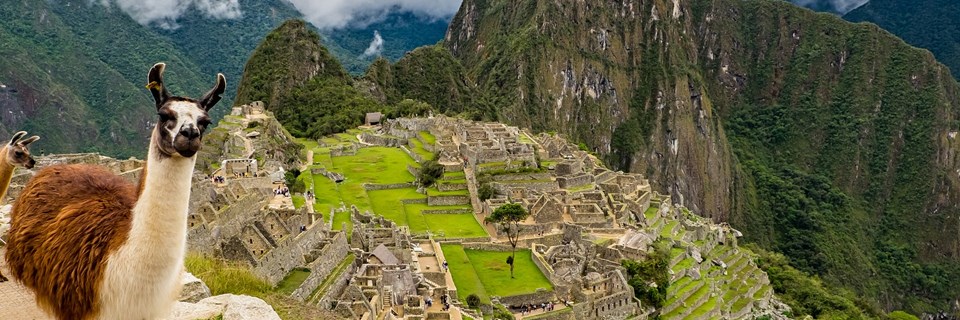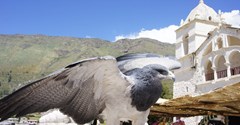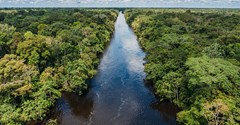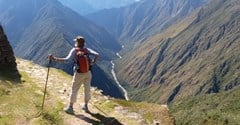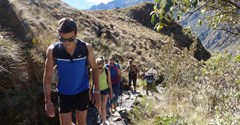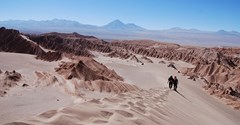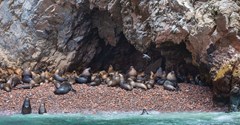Unlock the mysteries of one of the world's greatest civilisations at the best Inca ruins and archaeological sites in Peru and Bolivia.
South America's abundance of outstanding Inca ruins and archaeological sites allow us to piece together the story of the ancient civilisation and unlock the mysteries of life during the reign of the Incas. Ranging from powerful citadels in the clouds to remote royal retreats, elaborate temples, ingenious crop terracing and sacred rocks, these locations reveal the resourcefulness, power, devotion and innovation with which the Incas ruled and peel back the layers of intrigue on their societal order and sacrificial rituals and ceremonies.
Join us as we travel from the Inca heartland of the Sacred Valley, down to the sacred waters of Lake Titicaca and into Bolivia as we present our favourite Inca archaeological sites and how you can best experience them for yourselves.
Machu Picchu
Our list of the best Inca ruins starts at the famed lost citadel of the Incas, a magnificent royal complex sat amid misty cloud forest above a deep ridge above the Sacred Valley. Machu Picchu is the most well-known, well-preserved and spectacularly located Inca archaeological site in Peru and therefore is the most visited. It was built around 1450, as the Incas spread their empire outwards from the capital Cusco, led by their visionary leader Pachacuti Inca Yupanqui.
The sheer scale of the site, the immense size of the stones and the rather inaccessible location are all testament to the remarkable ingenuity, ambition and man-power displayed by the empire in creating such a lavish and durable complex in the clouds. Huge stones are perfectly pieced together without mortar like giant jigsaws, whilst large agricultural terraces wrap improbably around steep mountainsides. Within this former royal palace-cum-ancient citadel we find areas dedicated to sacrificial ceremonies, astronomical observations, worshipping of the sun god Inti, large-scale food storage and even prisons.
Visiting Machu Picchu in person allows us to truly appreciate this magnificent hidden citadel within its breathtaking setting, surrounded by lush green hills, far from civilisation. It is a sight and experience that no amount of postcard-perfect pictures can quite prepare you for, whether you have hiked for days to get to the Sun Gate or ridden the train from the Sacred Valley or from Cusco. Your guide will take you back centuries, to a time when the Inca empire flourished, to recreate life here in ancient Peru.
How to visit: Machu Picchu is most commonly reached via train from Ollantaytambo in the Sacred Valley or Poroy on the outskirts of Cusco and visited as part of an overnight stay in Machu Picchu Pueblo. It can also be experienced as part of a day trip from Cusco and, of course, is the finishing point for the four day Inca Trail.
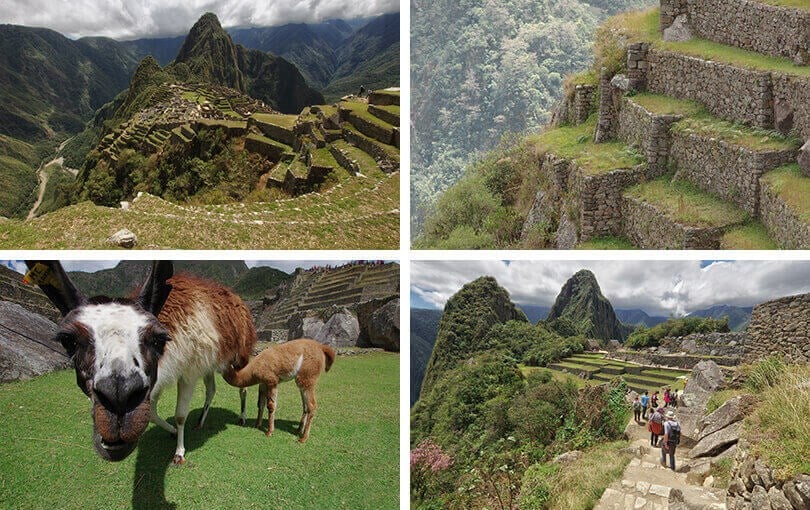
Pisac
Situated at a strategic position on a hilltop at the eastern end of the Sacred Valley is the Inca fortress town of Pisac. The site overlooks a deep gorge, with large terracing wrapping around the mountainsides and forming memorable vistas of the surrounding valley. Among the most important structures in Pisac are the royal baths complex, the Temple of Sun, the Temple of Heaven, military stations and areas dedicated to astronomy and sacrifices. These remains and the obvious agricultural activities hint at the scale, usage and importance of the town in Inca times, before it was destroyed by the European colonists in the 16th century.
Today, Pisac is again a thriving small town, with one of the region's largest and most colourful markets.
How to visit: Pisac is best visited as part of a full day tour of the Sacred Valley, perhaps in conjunction with Ollantaytambo, the Maras Salt Ponds and the Moray terraces.
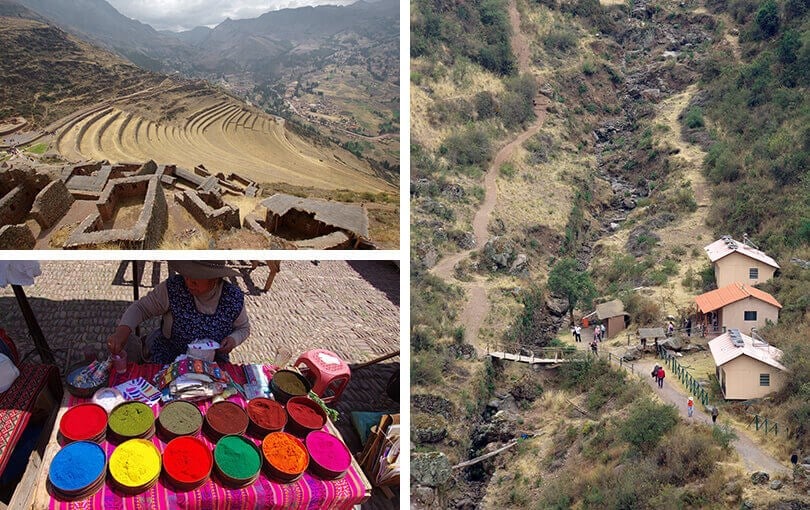
Ollantaytambo
Our next entry on the run-down of the best Inca ruins in South America takes us to the other end of the Sacred Valley. Much like Machu Picchu, Ollantaytambo existed in part as an imperial retreat, as well as an administrative centre, a fortress and a small city of around 1,000 inhabitants. It was established relatively late on in the Inca empire, overlooking an important road from Cusco to Machu Picchu and near the confluence of the Urubamba and Patakancha rivers. The site was comprised of immense terraces, which provided protection for the fort, royal bathing quarters and a fine example of a temple dedicated to Inti, which was still being built when the first wave of Spanish arrived.
Ollantaytambo is notable as the scene of one of the Inca's greatest victories against the invaders, though the city was eventually defeated in 1537. When the Incas were forced to flee from Ollantaytambo, it is believed that their decision to head to Victos and then the fortified Vilcabamba and not to Machu Picchu meant that the latter would not be discovered by the Europeans.
Today Ollantaytambo is a small town which still preserves its largely traditional and agricultural way of life.
How to visit: Ollantaytambo can be combined with visits to Pisac, Moray and the Maras Salt Ponds in a full day trip through the Sacred Valley.
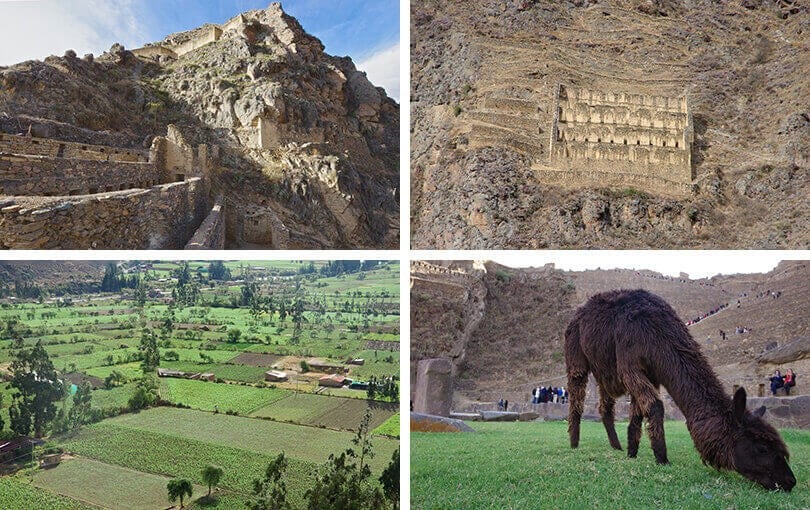
Moray
A rare example of elliptical terracing, Moray demonstrates an aptitude for finding ingenious ways to feed the immense Inca population. The terracing enabled different crops to grow and thrive at differing levels, altering the degrees of shade and sun and subtly varying the altitude.
A great deal of mystery and intrigue still surrounds the terracing, with the general consensus amongst experts being that they were used as a laboratory or research tool for different types of crops. This is backed-up by the evidence of soil from other areas of the surrounding Andean valley, having been imported to the site for testing. Thus the decision about which crops to grow in different climatic conditions and elevations around the Sacred Valley might have been taken here.
How to visit: Moray is located in the heart of the Sacred Valley and is visited in conjunction with the spectacular pre-Inca salt ponds of Maras, as well as Ollantaytambo and Pisac.
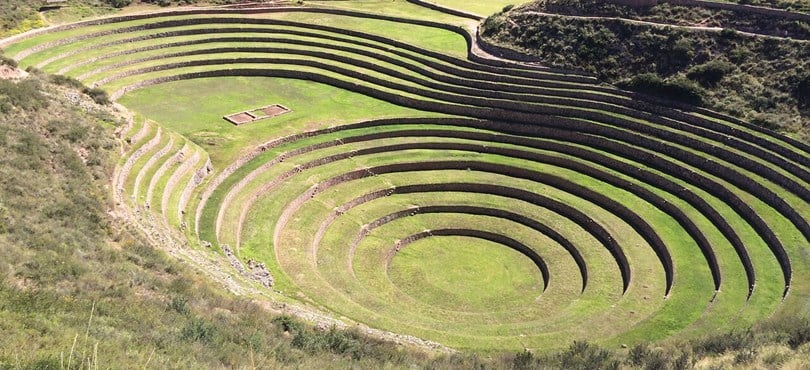
Inca Trail Ruins
Rather than one single ruin, the next entry combines five of the best Inca ruins on the Inca Trail to Machu Picchu. The ancient path leads past numerous important Inca sites and through landscapes as diverse as cloud forest and high mountain passes. One of the first major archaeological sites is Patallacta, a major agricultural centre that was largely burned down by a retreating Pachacuti Inca Yupanqui in a desperate attempt to stop his Spanish pursuers in their tracks.
Further along is the circular ruin of Runkurakay, perched on a mountain pass at an elevation of 4,000 metres. From here, one can enjoy panoramic views of the landscape, making it ideal as a watchtower or a tambo resting stop on the way to Machu Picchu, the two most likely uses. One of the most picturesque ruins on the Inca Trail is that of Wiñay Wayna, where graceful terracing leads round to a small cluster of stone buildings, behind which are a series of cascades, nestled amid verdant cloud forest.
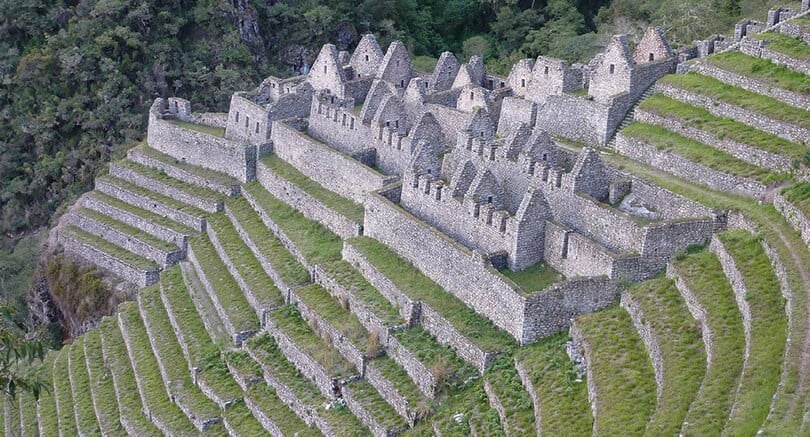
Inca ruins of Wiñay Wayna (photo by Cédric Liénart)
Getting closer to Machu Picchu brings us to Phuyupatamarca, which you might find easier to refer to as the 'City in the Clouds'. The crop terracing, ceremonial baths, freshwater fountains and the Temple of Sun formed the most important parts of this former town. The final archaeological site encountered before the mythical sanctuary is Intipunku - the Sun Gate. It is from here that intrepid hikers get their first glimpse of the lost citadel and enter the site, just as the Incas would have done centuries ago. Intipunku served as a fortress that controlled entrance into Machu Picchu, allowing those that passed a sumptuous view down towards the citadel. The site also has a deeply symbolic meaning, designed to allow the sun to pass through the gate on the winter solstice each year.
How to visit: These ruins are visited as part of the four day classic Inca Trail from kilometre 82, just past Ollantaytambo, all the way to the Sun Gate at Machu Picchu. This can be done on a private basis, though more commonly as part of a group. Both options include porters, chefs and guides to enhance your experience and allow you to focus on the landscapes, history and physical challenges of the ancient route.
Sacsayhuaman
We now leave behind the Sacred Valley and head to the former Inca capital of Cusco, or more specifically to a large hill overlooking the northern part of the city. Forming the head of Cusco's puma-shaped layout is the imposing temple-fortress of Sacsayhuaman, built in the mid-15th century under the instruction of Pachacuti Inca Yupanqui. It is at once an imposing show of power and a structure designed to gracefully imitate and blend subtly into the surrounding landscape, best evidenced in the zig-zagging walls which mimic the curves of the mountains. It was used to both celebrate deities with sacrificial offerings and store masses of arsenal with which to defend the city from potential threats.
Sacsayhuaman was largely dedicated to the worship of Inti, the Inca sun god. At its heart is an unusual circular stone temple and the site was the scene for regular sacrifices and the annual Inti Raymi festival. Held every June to mark the winter solstice, the Festival of the Sun endures to this day, a colourful affair with traditionally-dressed participants re-enacting ceremonial procedures and dances.
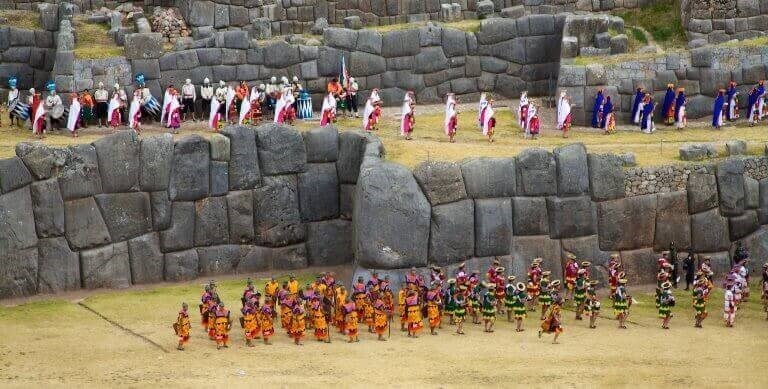
Intyi Raymi fesitval at Sacsayhuaman (photo by McKay Savage)
Just like Machu Picchu and many other Inca sites, Sacsayhuaman was an immense undertaking. Although a great deal of the structure was destroyed by the Spanish and its stones repurposed to build Cusco's colonial churches, its vast walls preserve one of the finest examples of the precision and the craftsmanship with which the Incas constructed their fortresses and cities, as well as the emphasis placed on harmonious integration with the landscape.
How to visit: Sacsayhuaman is visited on an in-depth tour of Cusco to gain a full picture of the ancient Inca and colonial era heritage which converge in the city. More of which in our next entry...
Qoricancha
Number seven takes us into the heart of Cusco. Today we can find numerous examples of Spanish churches and mansions having been built atop the foundations of Inca structures. The best and most significant example of this is Qoricancha.
Once a richly gilded temple dedicated to Inti, Qoricancha was the most sacred and precious temple and pilgrimage destination in the entire Inca empire. Rebuilt under the guidance of leader Pachacuti Inca Yupanqui, it was supposedly inspired by the megalithic stone structures of the preceding Tiwanaku civilisation. From here, a series of ceques radiated outwards, sacred paths used for religious processions, land regulation and linking together shrines. Inside Qoricancha lived around 4,000 priests, alongside the mummified remains of some of the most venerated Inca rulers.
The priests have long since departed and Qoricancha was quickly stripped of its precious gold and much of it destroyed. In its place today stands the colonial era Santo Domingo church and convent, the most vivid example of how Inca beliefs were ruthlessly supplanted with those of the Europeans. However, small parts of the original structure remain, including some of the trapezoidal walls of the sacred temple. The church itself is also one of the most impressive in Cusco.
How to visit: Qoricancha can be explored as part of an in-depth tour of Cusco, providing a detailed perspective on the convergence of the two great eras, embodied in the former Inca capital.

Tipon
A number of smaller and lesser-visited Inca archaeological sites are dotted around the Andean countryside just outside of Cusco. These include the 'red fort' of Puca Pucara, the sacred puma-shaped hueca stone of Qenko and the sacred fountains of Tambomachay.
Water also plays an important role in the ruins of Tipon, less than 20 miles from Cusco. Believed to have served as a walled royal complex and gardens, the site displays an elaborate water channelling, reservoir and irrigation system. It is rightfully considered to be one of the most architecturally appealing ruins in the Sacred Valley region, helped in no small part by the soothing presence of water running throughout.
Tipon is also often associated with one of Peru's most famous and unusual delicacies - cuy, more commonly known to you or I as guinea pig.
How to visit: Tipon is perhaps best combined with a visit to the pre-Inca Wari complex of Pikillacta and the Jesuit 16th century 'Sistine Chapel of the Americas' at Andahuayillas, on a fascinating day trip from Cusco through three distinct eras of Peruvian history.
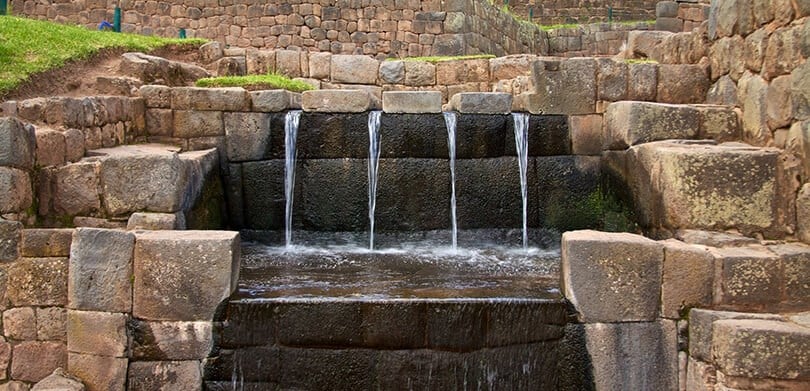
Tipon archaeological site (photo by McKay Savage)
Raqchi
For our penultimate Inca ruin we take the road south from Cusco towards the sacred waters of Lake Titicaca, stopping en-route at Raqchi, one of Peru's lesser-visited archaeological sites. At its heart was a magnificent 15th century temple dedicated to the all-powerful creator god Viracocha. Today, the central wall of this structure remains, standing tall at 12 metres high and stretching some 92 metres long. The stone, mud and adobe wall gives a clear indication of the majesty and scale of the temple, thought to have been enclosed by the largest roof in the Inca empire.
Aside from the temple, Raqchi shows vestiges of its other functions, including ceremonial baths, administrative centres, imperial housing and perhaps even military barracks. It was also thought to have been an important tambo resting place on the road to Lake Titicaca.
How to visit: Surrounded by rural farmland, Raqchi is an important and picturesque stop on the drive between Cusco and Lake Titicaca. Other stops include the Church of Andahuayillas, the replica Inca, colonial and suspension bridges of Checacupe, the snow-capped mountains of the La Raya pass and the small town of Pucara, famous for its porcelain bulls.
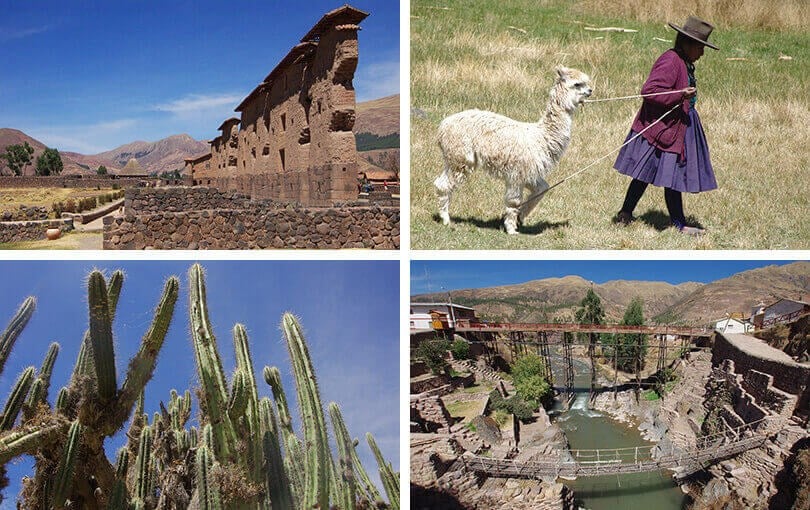
Isla del Sol & Isla de la Luna, Lake Titicaca
Our final port of call on our list of the 10 best Inca ruins and archaeological sites actually takes us across the border to Bolivia. More specifically, we head to the centre of Lake Titicaca and the sacred Isla del Sol (Sun Island) and Isla de la Luna (Moon Island).
Believed to be the place where Viracocha created the sun and the moon and where Inti created Manco Capaca and Mamo Occlo - the first Incas - the Sun Island is one of the most revered parts of the entire Inca empire. This adulation was encapsulated in a shrine to Viracocha which, along with Qoricancha in Cusco, became one of the most important pilgrimage destinations for the Incas. This and many other monuments were sacked and damaged by the Spanish colonisers, but today over 80 Inca ruins remain on the island.
Among the most important sites on the northern part of the Sun Island are the 'Rock of the Puma', from where the sun rose and from which the lake may have taken its name, the maze-like palace complex of Chincana and the ceremonial stone table, where both human and animal sacrifices were thought to have been made. On the southern side we find the 200 step Inca staircase, leading to the Fountain of Youth and also the temple of Pillkukayna, overlooking the strait of Yampupata and Chelleca Island.
The most important site on Moon Island is the Temple of the Chosen Virgins of the Sun. This acllahuasi (monastery) housed Inca females who lived nun-like lives in honour of Inti and who took part in ceremonies of worship.
How to visit: The Sun and Moon Islands are visited on catamaran trips from the town of Copacabana, itself home to an important church. This is typically combined with a day spent on the Peruvian side of the lake, visiting the picturesque island of Taquile and the floating Uros Reed Islands.
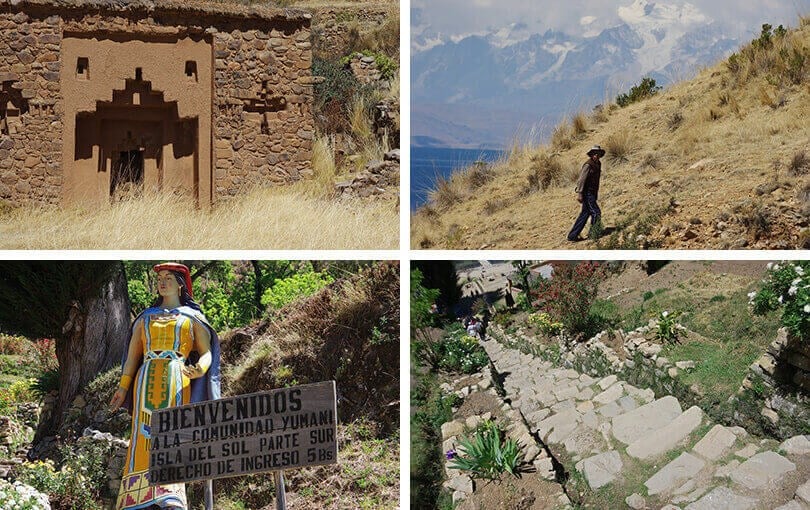
Inspired to take your own Peruvian holiday to discover some of the country's best Inca ruins? See below for a selection of itineraries, which provide in-depth perspectives on life in Inca times and modern day Peru, as well as an exploration of some of the country's best landscapes. Alternatively send us over an email or pick up the phone to discuss your own tailor-made Peruvian adventure!
Choose your perfect holiday
Find inspiration from our selection of itinerary suggestions, a great starting point for your next trip
View More Tours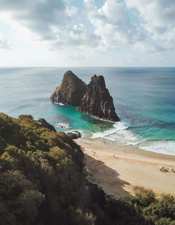
Stay in touch
Infuse your travels, with inspiration from our monthly newsletter.
READY - 20 April 2024
LANDMARK TOURS: Multi-Country & Cross Continent. New Cosmopolitan Tour: Buenos Aires, Iguazu, Rio
CHINA & INDIA: Local Life, People & Unique Cultures
GUIDES by Veloso Tours, are the best Local Hosts
PRIVATE VILLAS: Quality Time in exclusive settings
TRAVEL INSURANCE with extensive COVID-19 cover
